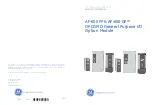
Chapter 1
Introduction
NI-FBUS Hardware and Software User Manual
1-2
ni.com
The PCI-FBUS/USB-8486 uses a standard DB-9 male D-SUB connector to
attach to the Fieldbus network. The PCMCIA-FBUS connects to the
fieldbus by using a cable that provides two connectors to attach to the
fieldbus network DB-9 male D-SUB connector and Combicon-style
pluggable screw terminals.
HSE
The National Instruments FBUS-HSE/H1 is a high-speed Ethernet (HSE)
linking device that couples a 10/100 Mb/s Ethernet network to two H1
F
OUNDATION
™
Fieldbus segments. The linking device complies with
Class 42a-2 of the HSE profile and acts as the link-active scheduler (LAS)
for the H1 segments, as well as managing all fieldbus communications. It
provides connectivity to H1 devices through HSE networks and supports
function block configurations and scheduling on H1 segments. The
FBUS-HSE/H1 linking device, serving as link masters for 31.25-kbps
H1 segments connected to the HSE network running at 10 Mbps or higher,
is a crucial component in F
OUNDATION
™
Fieldbus technology.
The combined H1/HSE solution allows for full integration of sensor,
process/discrete control, and hybrid/batch control subsystems with higher
level, supervisory applications. The HSE linking device is the key to
integrate H1 and HSE technology.
NI-FBUS Software Products
Communications Manager
The NI-FBUS Communications Manager implements a high-level
Application Program Interface (API) that lets you communicate with the
National Instruments F
OUNDATION
™
Fieldbus communication stack and
hardware. It provides a high-level API advanced users can use to interface
with the National Instruments F
OUNDATION
™
Fieldbus communication stack
and hardware.
Configurator
Most NI-FBUS users use the NI-FBUS Configurator. In addition to
providing the functionality of the NI-FBUS Communications Manager in a
graphical format, it includes additional functionality to allow you to
configure a Fieldbus network. It can automatically generate the schedule
for the network and configure field devices and hosts to transmit and
receive alarms and trends.












































